I love getting writing book recommendations from other authors, so I thought Writing and Wellness readers might like to know which books I keep on my writing desk.
The following 10 are earmarked and broken-backed because I turn to them so often. Maybe one of these needs to be on your personal gift list?
10 Writing Books I’m Grateful For
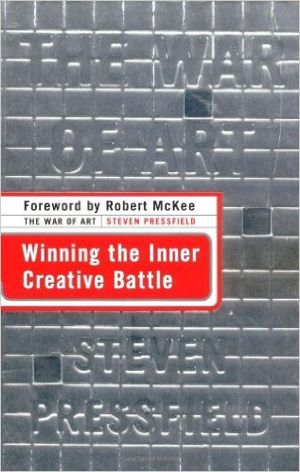 1. The War of Art
1. The War of Art
by Steven Pressfield
No matter how many other writing books I may read, I have no doubt this one will remain my favorite. It’s held that place for the past 10+ years and I don’t see it changing. When I’m struggling, I open it to a random page and find inspiration there. For that reason I’m glad to have the hardcover (pictured here), but the paperback is now also available.
Think of The War of Art as tough love… for yourself.
Since 2002, The War of Art has inspired people around the world to defeat “Resistance”; to recognize and knock down dream-blocking barriers and to silence the naysayers within us.Resistance kicks everyone’s butt, and the desire to defeat it is equally as universal. The War of Art identifies the enemy that every one of us must face, outlines a battle plan to conquer this internal foe, then pinpoints just how to achieve the greatest success.Though it was written for writers, it has been embraced by business entrepreneurs, actors, dancers, painters, photographers, filmmakers, military service members and thousands of others around the world.
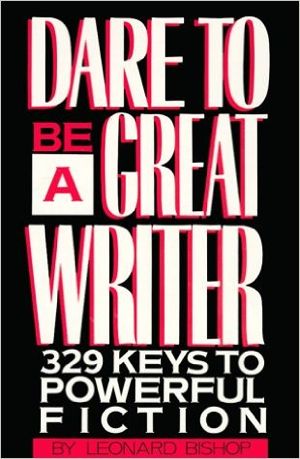 2. Dare to be a Great Writer
2. Dare to be a Great Writer
by Leonard Bishop
I found this one early on in my writing career in a used bookstore. What I love about it is that it’s full of short little pieces of advice on not only the craft of writing, but on managing a writing career as well. So many of these are worth a second or third look—my hardcover is riddled with earmarks. Bishop has a talent for quickly summarizing a truth, and then giving very clear examples all in the space about three quarters of a page. Looks like it may be out of print, but Amazon still has some used ones available.
Solid, no-nonsense writing instruction, dispensed out in 329 easily digestible portions, to help fiction writers polish their skills and support their talent with cultivated craft.
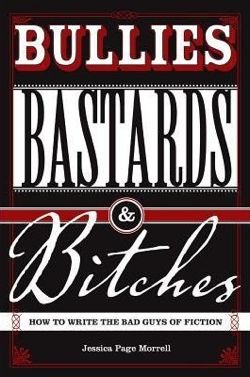 3. Bullies, Bastards & Bitches
3. Bullies, Bastards & Bitches
by Jessica Page Morrell
I use this one as a reference book for antagonists. When I feel like mine just isn’t ringing true yet, or if something is missing in the battle with the protagonist, I’ll pick up this book and find gold. Morrell does a great job mapping out 12 types of bad guys, including their typical motivations, characterizations, and roles. If you’re struggling to create that tension you need in your story, this book will help.
A truly memorable antagonist is not a one-dimensional super villain bent on world domination for no particular reason. Realistic, credible bad guys create essential story complications, personalize conflict, add immediacy to a story line, and force the protagonist to evolve.
From mischief-makers to villains to arch nemeses, Bullies, Bastards & Bitches shows you how to create nuanced bad guys who are indispensable to the stories in which they appear. Through detailed instruction and examples from contemporary bestsellers and classic page-turners, author Jessica Page Morrell also shows you how to:
- Understand the subtle but key differences between unlikeable protagonists, anti-heroes, dark heroes, and bad boys
- Supply even your darkest sociopath with a sympathetic attribute that will engage readers
- Set the stage for an unforgettable standoff between your hero and your villain
- Choose the right type of female villain—femme fatale, mommy dearest, avenger, etc.—for your story
Bullies, Bastards & Bitches is your all-encompassing bad-guy compendium to tapping into any character’s dark side.
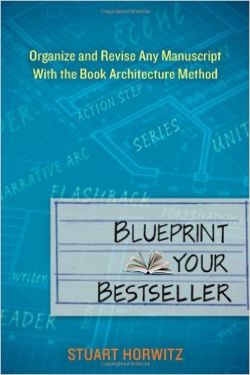 4. Blueprint Your Bestseller
4. Blueprint Your Bestseller
by Stuart Horwitz
This is my go-to after I’ve finished my first draft. I’m a pantser, so my first draft is only a shell of clues pointing toward the story. I have to then figure out what story I want to tell. That can be tough, so I often turn to this book for help. Horwitz has a unique method of tearing your draft apart so you can put it back together with a cohesive plot. You’ll need some floor space and a pair of scissors!
In Blueprint Your Bestseller, Stuart Horwitz offers a step-by-step process for revising your manuscript that has helped bestselling authors get from first draft to final draft. Whether you’re tinkering with your first one hundred pages or trying to wrestle a complete draft into shape, Horwitz helps you look at your writing with the fresh perspective you need to reach the finish line.
Blueprint Your Bestseller introduces the Book Architecture Method, a tested sequence of steps for organizing and revising any manuscript. By breaking a manuscript into manageable scenes, you can determine what is going on in your writing at the structural level—and uncover the underlying flaws and strengths of your narrative.
For more than a decade this proven approach to revision has helped authors of both fiction and nonfiction, as well as writers across all media from theater to film to TV.
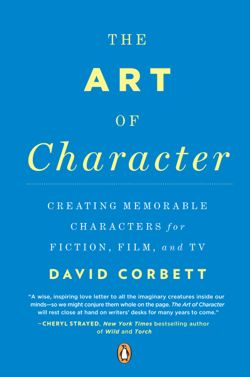 5. The Art of Character
5. The Art of Character
by David Corbett
Character is something we can work on our entire lives and still feel like beginning students. This is one of the best books I’ve found on this part of the writer’s craft. Corbett is a great teacher of all facets of character. He teaches us to dig deep into motivation, conscious and unconscious traits, wounds and vulnerability, growth, conflict, and more. Find exercises at the end of each chapter.
Former private investigator and New York Times notable author David Corbett offers a unique and indispensable toolkit for creating characters that come vividly to life on the page and linger in memory. Corbett provides an inventive, inspiring, and vastly entertaining blueprint to all the elements of characterization-from initial inspiration to realization-with special insights into the power of secrets and contradictions, the embodiment of roles, managing the “tyranny of motive,” and mastering crucial techniques required for memorable dialogue and unforgettable scenes. This is a how-to guide for both aspiring and accomplished writers that renders all other books of its kind obsolete.
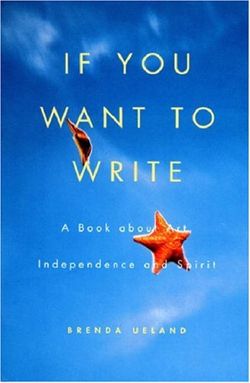 6. If You Want to Write
6. If You Want to Write
by Brenda Ueland
I enjoyed this book so much that I actually bought it twice! I found it once when I first started writing, and then came upon it again over 10 years later. I still have both copies. Ueland speaks to your writer’s soul, and it seems as if she can look right into it and know what you’re struggling with. She even has a chapter specifically for women entitled, “Why Women Who Do Too Much Housework Should Neglect it for Their Writing.”
Brenda Ueland stresses the idea that “Everyone is talented, original, and has something important to say.” Drawing heavily on the work and influence of William Blake, she suggests that writers should “Try to discover your true, honest, un-theoretical self.” Carl Sandburg called If You Want to Write “the best book ever written on how to write.”
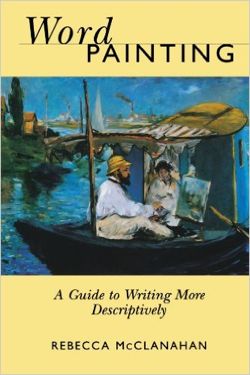 7. Word Painting
7. Word Painting
by Rebecca McClanahan
If you want to add some magic to your prose, or if you feel like your phrases and sentences are getting old and stale, pick up this book. I’ve had it for years, but I’ve yet to make it through the entire thing because I always find something that inspires me to try something new within just a few pages. There are SO many helpful tips in here for describing character, setting, and a character’s inner thoughts, but the author goes beyond that to help you see how description can shape the narrative line. Read this and be surprised at how much more you could be doing with your description!
Let Rebecca McClanahan guide you through an inspiring examination of description in its many forms. With her thoughtful instruction and engaging exercises, you’ll learn to develop your senses and powers of observation to uncover the rich, evocative words that accurately portray your mind’s images. McClanahan includes dozens of descriptive passages written by master poets and authors to illuminate the process. She also teaches you how to weave writing together using description as a unifying thread.
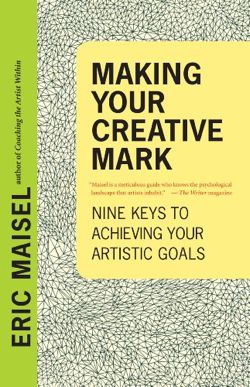 8. Making Your Creative Mark
8. Making Your Creative Mark
by Eric Maisel
Okay, I listed just one book here, but I’m actually recommending a trio by this author. THE guru on the psychology of creativity, Maisel is someone every writer should be reading, in my opinion. He knows how our minds work, and how to inspire us to get out of our own way and create our best work.
An example from this book:
“Many people let their safety needs trump their freedom needs and live a restricted life based on the concept of safety. Others—and this is a real problem for artists—substitute habitual thinking for fresh, free, in-the-monent thinking so as not to rock their world with the freedom of fresh thought. People flee from freedom all the time—and artists flee from freedom in their own special ways. Do not be that kind of artist!”
Eric Maisel’s prolific, multifaceted career is a testament to his profound understanding of what it takes to live out one’s creative ambitions. A therapist who is also a bestselling author, coach (and coach trainer), columnist for Professional Artist magazine, and featured blogger for Psychology Today and the Huffington Post, Maisel is an expert on all that blocks the creative. In Making Your Creative Mark, Maisel distills his decades of coaching, teaching, listening, and creating into nine keys, including Passion, Confidence, Empathy, Stress, and Relationship. Each key’s lesson helps creators implement real solutions to their individual challenges. Whether they are writers, painters, actors, composers, or craftspeople, readers will learn to “unlock” what has kept them from beginning, continuing, completing — and succeeding.
Also recommended:
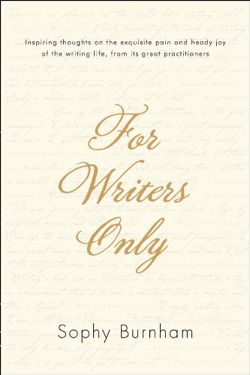 9. For Writers Only
9. For Writers Only
by Sophy Burnham
The inspiring quotes throughout this book are the icing on the cake. If you’re feeling unsure about your writing, alone in your pursuits, or just discouraged over some recent difficulties, pick up this book. Burnham helps you realize that you’re in good company—all artists go through similar emotions. This book is a true solace for a writer.
An example:
“I will say this: no loneliness or solitude matches the fatigue and awful lonesomeness that comes in crowds or in continually being available to others at the expense of your inner voice….The loneliness of artistic creation, after all, is momentary, because the act of creating creates that perfect unity when Time stands still and you experience only stillness, and in utter emptiness the fullness of your Self.”
“I see but one rule: to be clear.” Stendhal
If only it were as easy for most writers as it was for Stendhal. The truth about the act of writing is much more varied, even violent. In fact, there seem to be as many contradictory admonitions about how to go about doing it as there are writers themselves.
With that in mind, writer Sophy Burnham has collected the thoughts of some of the greatest writers and laced them with her own observations and experiences of the writer’s life. With an emphasis on the emotions that writing wrings from those who practice it, Burnham writes about beginning a work prematurely, the ecstasy when the writing is really flowing, the crash that can follow the flight — and how to pick yourself up and continue. Most of all, you will be reassured, enlightened, and inspired to learn that, in your own writing struggles, you are not alone.
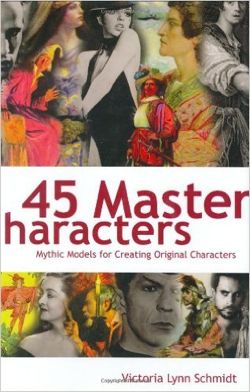 10. 45 Master Characters
10. 45 Master Characters
by Victoria Lynn Schmidt
If you’re struggling to flesh out any of the characters in your story, this book—built on mythic models—can help. Not only will you find new characters, but Schmidt helps you see some of the ones you already have more clearly. This is a true guide. For each character type you’ll find what that character cares about, what he fears, what motivates him, how others see him, and his assets and flaws. You’ll also find both the heroic and villainous sides of this character, so you can apply him either way in your story.
45 Master Characters will make your characters and their stories more compelling, complex and original than ever before.
You’ll explore the most common male and female archetypes—the mythic, cross-cultural models from which all characters originate—and learn how to use them as foundations for your own unique characters. Examples culled from literature, television and film illustrate just how memorable and effective these archetypes can be—from “Gladiators” and “Kings” like Rocky Balboa and Captain Ahab to “Amazons” and “Maidens” like Xena and Guinevere.
The mythic journeys of heroes and heroines—the progression of events upon which each archetype’s character arc develops—are also examined. Building such a “journey” into your character’s story will enable you to stop worrying about what happens next and get on with telling your tale.
It’s a power-packed method for creating characters that stand the test of time!
Also recommended by this author:
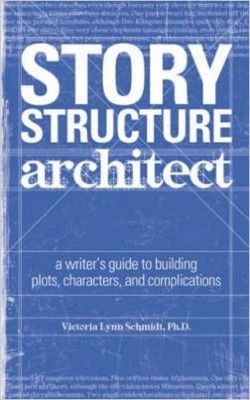 Story Structure Architect
Story Structure Architect
Plot and character guide for most all types of stories!
It’s been said that there are no new ideas; but there are proven ideas that have worked again and again for all writers for hundreds of years.
Story Structure Architect is your comprehensive reference to the classic recurring story structures used by every great author throughout the ages. You’ll find master models for characters, plots, and complication motifs, along with guidelines for combining them to create unique short stories, novels, scripts, or plays. You’ll also learn how to:
–Build compelling stories that don’t get bogged down in the middle
–Select character journeys and create conflicts
–Devise subplots and plan dramatic situations
–Develop the supporting characters you need to make your story work
Especially featured are the standard dramatic situations inspire by Georges Polti’s well-known 19th century work, The Thirty-Six Dramatic Situations. But author Victoria Schmidt puts a 21st-century spin on these timeless classics and offers fifty-five situations to inspire your creativity and allow you even more writing freedom. Story Structure Architect will give you the mold and then help you break it.
This browsable and interactive book offers everything you need to craft a complete, original, and satisfying story sure to keep readers hooked!
What books would you recommend for writing and creativity?


Good suggestions, Colleen, I’m adding a few of these to my wish list! I’ve got one to suggest:
Wired for Story: The Writer’s Guide to Using Brain Science to Hook Readers from the Very First Sentence by Lisa Cron.
It was part of an online writing class I took from UCLA with Caroline Leavitt, and really helpful in working through my story.
Awesome. Thanks, Jann. I’ve heard of that one but don’t think I’ve read it. Off to check it out. :O)
I keep hearing about The War of Art, and haven’t read it. I’m going to get it on your rec, Colleen! I’m not terribly big on how-to books for writers, but your list has me going to take a look at these 🙂
I’d love to know what you think, Susan. He speaks a lot about “resistance” and I sure see it in my life, so the book really rings true for me.